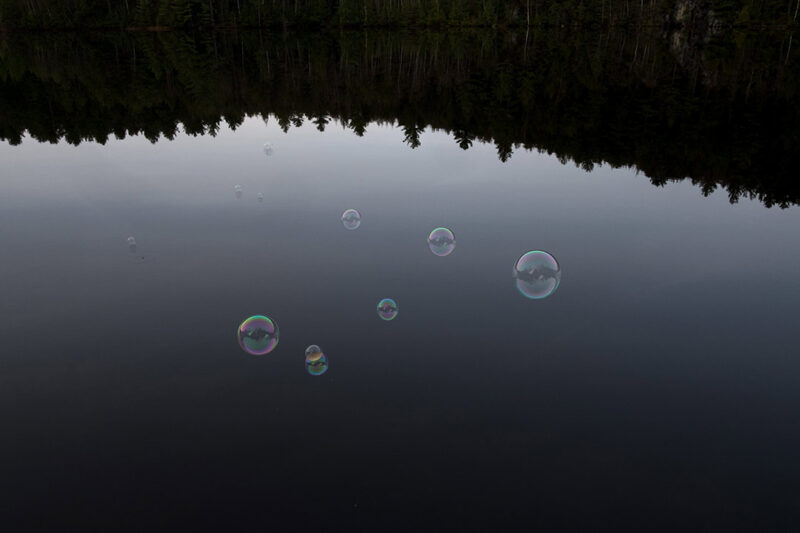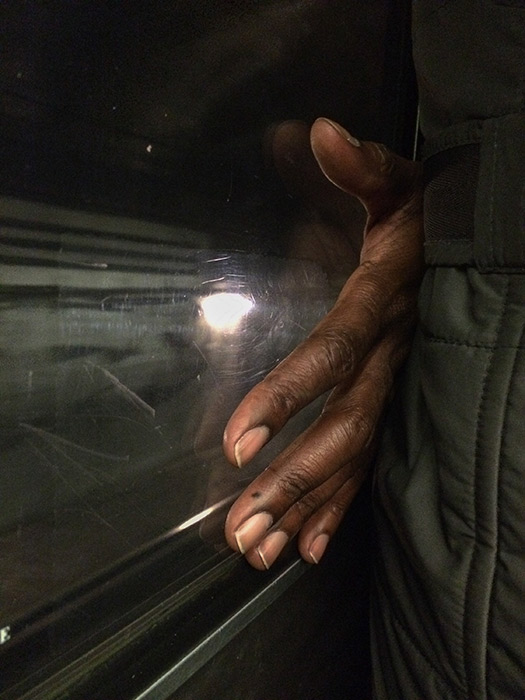[November 9, 2023]
By Louis Perreault
Photographers extract from reality fragments of space-time that they see as meaningful. From these shots are then decanted the images with the greatest potential for building a series or sequence. Thus, photographers follow a principle of subtraction: from a larger grouping they patiently distill the essence of the artwork to come. As they conduct this pruning process, their artistic sensibilities are activated, their vision is clarified, their language is defined.

Bertrand Carrière, Une poignée d’étoiles, Paris, Éditions Loco, 2023, 17 x 24 cm, 131 colour photographs, print hard cover, sewn binding, 232 pages.
If, moreover, they strive to portray the modulations of daily life, the task only expands. With meticulous attention to ripples of experience and to what Bertrand Carrière calls the “irregularities … in the visible world,”1 they construct a network of reference points on the general map of their lives. The hard disks get filled, the contact sheets multiply, the printed proofs pile up. One could, in fact, subtract forever, separating the wheat from the chaff, but inevitably one must reverse this logic in order to reconstruct the photographic story through addition, offering images the support of their equivalencies and complements, giving body to a grouping that will be greater than the sum of its parts, held together with a mortar that, it is hoped, will be solid enough to keep the edifice of the entire artwork standing.
Une poignée d’étoiles, Carrière’s new book, is indeed solid in structure, the result of such painstaking work of assembly. The narrative, built into a story in a series of short texts, is that of his private and professional life, which he delivers here in language that is direct and concise, though more generous than in the preceding volume of his photographic diary (Le capteur, published 2015).
Saint-Denis, March 2020 … Looked at the big trees scratching the steel sky. Listened to the rising stream. The song of the returning birds. The trees cracking. You almost hear the sap rising in the trunks. It’s syrup time. The crows are squabbling. The smell of wood burning. The days getting longer. Thought again about the life that the two of us are building in this retreat.
In addition to offering confidences about his life with his loved ones, observations of nature’s transformations, and the doubts and ambitions that influence the production of his creative projects, Carrière records some of the notable events in the history of recent years, providing a few hooks to which readers can attach their own personal stories. And so, even though the book is presented as mainly visual, it is essential to immerse oneself in Carrière’s intimate writing, which contextualizes or evokes certain images and, above all, acts as a catalyst for the imagination as one reads the book.
Although he exercises restraint in his writing, Carrière speaks richly and profusely through his art – his continual and assiduous collection of photographs and experienced eye for highlighting the symbolic and narrative potential of the still image.
Like the text, the sequence of images brings us into his private spaces, where we find, among other things, his lover, his grandsons, and his self-portraits. We navigate, in parallel, through his creative world, replete with references to movement and travel – perfect drivers for his creativity – and punctuated by the repeated presence of books, a recurrent motif in his work. Landscapes seen through an open window and a few images inverted by various optical effects denote the act of seeing, testifying to Carrière’s particular affection for the photographic apparatus and its special hold on the world. A few images of the city bring to the centre of this personal universe the anguish of a wounded world, portrayed in the dark hues of night and in the traces left by people in the public space.
In a way, Carrière’s work follows the ups and downs of his life, advancing through its low points and its upsurges in intensity, as a response to the indomitable nature of life. A child concentrating on a game, an MRI machine, a well-made bed, a table set for a meal, springtime buds, panoramic shots of the river, an iced-over lake, the portrait of a friend, a shadow on the asphalt: from this panoply of subjects is formed a constellation of light bursts, a handful of stars to celebrate the fragmentary nature of what remains beyond experience.
Une poignée d’étoiles adds to the catalogue of Éric Cez’s French publishing house, Éditions Loco, which is putting out more and more books by Quebec photographers. These 230 pages of words and images, simply laid out and printed on paper with a subtle, soft texture, will confirm, to those who are not yet convinced, that books can act, in complete independence, as a form of expression on their own. Translated by Käthe Roth
Born in Ottawa in 1957, Bertrand Carrière has developed a personal and varied photographic practice involving both a documentary approach, in which he focuses on the memory and history of places, and one that is more intimate, characterized by attention to the irregularities of the visible world. The author of many photobooks since 1995, he has exhibited his work in Quebec, the United States, Europe, Argentina, and China. He is represented by Galerie Simon Blais in Montreal, the Stephen Bulger Gallery in Toronto, and Agence VU in Paris. www.bertrandcarriere.com
Louis Perreault lives and works in Montreal. His practice is deployed within his personal photographic projects and in publishing projects to which he contributes through Éditions du Renard, which he founded in 2012. He teaches photography at Cégep André-Laurendeau and is a regular contributor to Ciel variable, for which he reviews recently published photobooks.








